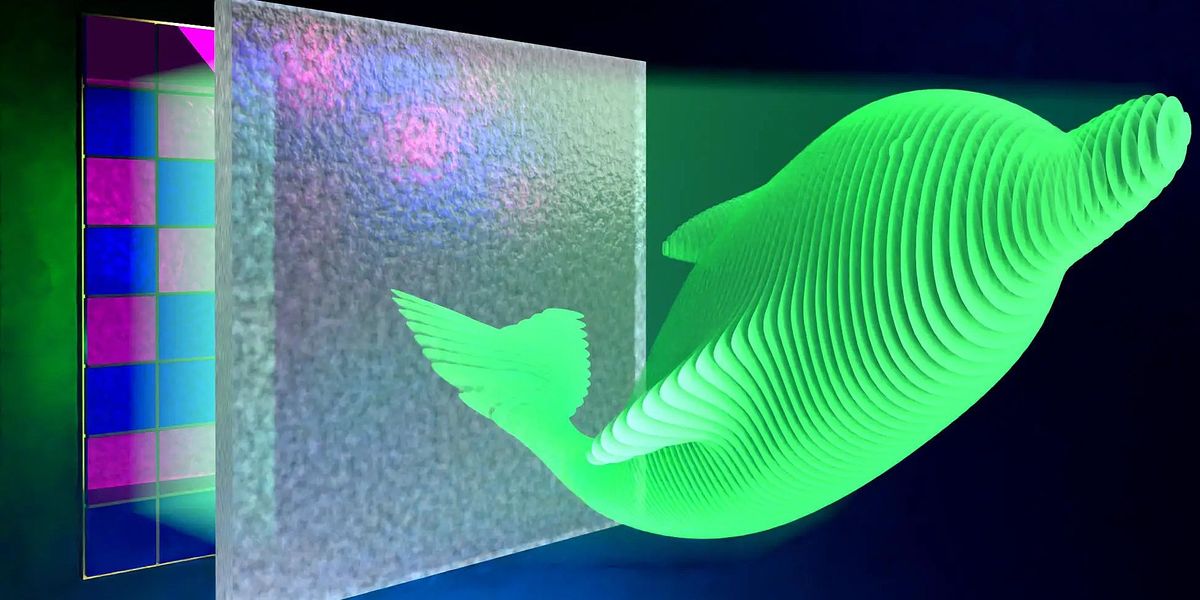Sharper 3D Holograms Come Into Focus

Actual 3D holograms may be achievable in a projected medium that aren't blurry or fuzzy but still appear to have real depth, according to a new study. The researchers, based in China and Singapore, exerted a new level of control over the hologram projection's scattering medium.
Much like flying cars or warp-speed travel, holograms are a kind of technology that was overpromised by science fiction but underdelivered in reality. Today this technology is advanced enough to resurrect pop stars, like Whitney Houston, for convincing stage shows, but the depth of these projections mean that the hologram experience lacks convincing three-dimensionality. Low axial resolution-which is equivalent to the distance from the nearest image plane in focus to the farthest field in focus, also called depth of field-and high levels of crosstalk interference between projection planes have long prevented 3D holograms from achieving finer depth control.
One of the innovations the team developed is a modulating medium for projecting images-similar to what LCD display screens use.
Now, a research team from the University of Science and Technology of China and the National University of Singapore have reported a new technique to solve both of these problems at once to create ultrahigh-density 3D holograms.
Our work presents a new paradigm towards realistic 3D holograms that can deliver an exceptional representation of the 3D world around us," says senior author on the paper, Lei Gong, an associate professor of optical engineering at the University of Science and Technology of China. Gong and colleagues call this method 3D scattering-assisted dynamic holography.
The new method might benefit real-life applications such as 3D printing, optical encryption, imaging and sensing, and more," he continues.
Large-scale 3D holograms are typically created by scattering a projection across many planes to create a stack of pixels that when viewed together give the impression of a virtual, 3D object. Stacking these image planes close together can create high-density images. However increasing the plane density can also generate interference in the form of cross talk, Gong says.
In short, cross talk is the mutual-intensity interference between images projected at different depths," he says.
Even though a projection is broken into separate image fields, interference can occur when light from one plane filters through into the others. Like a pen bleeding through from the front of a sheet of paper to the back, this filtering can cause interference because the light for each plane contains unique pixel information. As a result, blurred images are created when this light bleeds through.
[This] restricts the depth control of 3D projections," Gong says.
In order to increase image-plane depth without creating blurry images, Gong and the team focused on how to shape the projection photons before they're scattered across multiple planes. Typically, the hologram projection is controlled by passing it through a spatial light modulator. SLMs are mediums made of physical and reflective barriers that modulate a light beam's amplitude, phase, and intensity. A TV with a liquid crystal display (LCD) is one example of an SLM.
However, these SLMs alone can limit the final hologram's resolution. To solve this and the cross-talk problem, the team introduced a scattering medium made from zinc oxide nanoparticles to help further scatter the projection's light. Introducing this additional medium served to increase the total amount of scattering the light experienced and created a greater range of diffraction angles. This greater range of angles made it possible to decorrelate, or disentangle, the image fields to reduce pixel correlation between planes. As a result, cross-talk interference via light bleeding through the image layers was reduced.
With the cross-talk issue addressed, the team was then able to stack the image planes more densely with less depth between them which helps to increase the 3D experience of the projection.
To verify the benefit of this approach, the team used both simulated and experimental scenarios. Where other scattering approaches limited the number of image layers to only 32 at a depth interval of 3.75 millimeters, simulations of the new scattering approach could generate 125 image layers at a depth interval of just under 1 mm.
In experimental trials, the researchers also reported reduced depth intervals and plane density compared to existing scattering techniques while generating minimal cross talk.
In addition to improving naked-eye 3D hologram visualizations and improving the viewing angle of holographic VR headsets, Gong says that this technology could also be implemented beyond virtual reality as well.
For the biomedical field, it might be used to project the 3D medical images that help the diagnosis and treatment."
But before these advancements can take place, the technology will need to move from point-cloud projections to solid ones. In order to bridge this gap, Gong says it will be necessary to develop new algorithms to handle the complexity of these 3D images.
A much higher pixel-count hologram is required to project complicated 3D scenes," Gong says. New algorithms, such as learning-based methods, should be developed for this purpose."
The researchers published their findings earlier this month in the journal Optica.